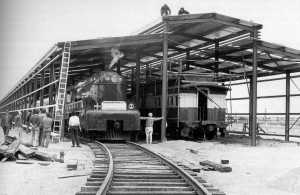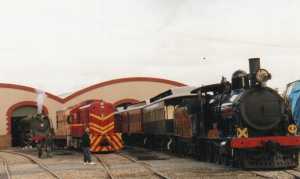|
The Australian Railway Historical Society (SA Division)
... was formally constituted in June 1952 when a group of twelve men from diverse backgrounds
met at Millswood to form a local Branch of what was then known as the “Australasian Railway &
Locomotive Historical Society”, subsequently renamed the ARHS (SA Division). Regular
meetings
were held to discuss railway topics and visits were arranged to workshops, signalling facilities
and to inspect locomotives, rail cars and stations.
- At first members travelled on regular passenger services or arranged for passenger
cars to be attached to goods trains to explore more isolated country lines.
- Membership grew quickly and special public charter trains were then organised.
- By the late 1960s up to 20 excursion trains were being run each year and there
were nearly 200 paid up members.
When early members joined in in the 1960s, they had no idea that once steam finished around Adelaide, it would still be alive in the 21st Century. ARHS members also assisted in 1973 to help Pichi Richi get started. Some clever engineering, fire and water and the romance of steam lingers on!
It was all started by twelve men interested in train travel. The “elders” of that early group alive today include David Parsons, Brian Castle, Doug Colquhoun and Dean Harvey. All remain interested in railways today but 1960s, 70s and 80s Tours Manager and President Dean Harvey stands out at the pinnacle of the group.
Dean had the foresight, knowledge and contacts to rescue many items before they were destroyed so that leases were obtained to build our own depot at Dry Creek and when change of gauge occurred, build a base at Mt Barker and another depot at Goolwa.
|
![[IMAGE]](images/history/first_trip.jpg)
The first organised excursion - to Mt Pleasant in Nov 1952 (NRM archives)
1. 1966 - The Decline of Steam in South Australia
When steam operations ceased in South Australia in April 1966, it was obvious to members that
the whole canvass of railway operations was changing in a major way. Through negotiation with
the SA Railways the Society assumed responsibilty for the maintenance and regular servicing of
four steam locomotives at the Mile End depot complex to enable the continuation of the now very
popular steam hauled trips.
A museum site was gradually established on leased land at Mile End to facilitate the
retention of selected condemned historic locos and railcars and to encourage preservation of a
representative collection of the quickly disappearing rail heritage that been so important in
the State’s development. The site was officially opened in December 1970. The museum amicably
separated from the ARHS in 1975 and has subsequently evolved into today’s impressive National
Railway Museum at Port Dock
2. Documenting our Rail Heritage
Over the years, the Society has published a number of large format glossy books describing
classic South Australian locomotives, contributes to a monthly national journal and, with the
NRM, publishes a bi-monthly magazine recording day to day rail activities in the State.
The Society is a founding member of the coordinating group
The Council of Historic Railways and Tramways of South Australia
reconstituted in 2010 as Heritage Rail South Australia Inc
3. 1978 - The Society’s rail tours activities entered a new era
- A season opening “Festival of Steam” was staged at Adelaide Station, with three
steam locomotives operating trains to Woodville and Salisbury, special carriages open for
inspection and displays and souvenir sales throughout the station.
- It was announced that a regular excursion train to Bridgewater would run twice a month and
more frequently in holiday periods - this was to be known as the “SteamRanger”
- A grant was obtained to allow volunteers to superficially refurbish 15 wooden passenger
cars at Edwardstown

4. 1980 - Our Own Depot at Dry Creek
But soon another crisis surfaced!
....rationalisation of the commercial railway system was well advanced and we were asked to
remove our four preserved locos from Mile End. After much lobbying, by year’s end a site was
found at Dry Creek and SteamRanger entered a new era of preserved steam operations
-
A grant of $270,000 from the government Unemployment Relief Scheme and lots of
fundraising allowed depot construction to commence in March 1979 with over 30 workers on site at
times.
- Work progressed with enthusiasm. Our photo shows loco 520 easing into the new
shed to test clearances. Finally, SteamRanger’s new home was officially opened by the
Premier in August 1979. Our locos, over 30 carriages and other rollingstock now had a long term
home!
- But the depot was much more than a storage shed, so the next steps were to fit out a
basic mechanical workshop, aided by valuable donations from our supporters, and accumulate all
the resources needed to stand on our own feet as a restoration and maintenance base.
- As facilities improved we engaged a full time fitter to support the volunteers and
commenced major repair tasks on all of our locos including a major rebuilding of loco 621 and
started rebuilding of F251 which had been acquired in poor condition from a static display at
Elizabeth.
5. And with a real home our Tours Programme grew apace
-
In 1970 we ran 16 excursion trains.
- In 1980, our first full year operating from our new depot, this had grown to 34 trains
- Longer distance trips increased - to Mt Gambier, the Riverland and almost to Melbourne
- Using our own sleepers and Club Car a weekend overnight excursion train was run to Victor
Closure of The Victor Line?
The sale of the SA Railways to the Commonwealth in 1978 saw a major
decline of rail lines across the State. Services on the Strath to Victor section were withdrawn
in 1980. Rail supporters and the South Coast community could see the signs - the complete line
would soon be closed - and lobbying for its retention was commenced by both the ARHS and the
local Victor based SAVRAIL group.
|
6. 1986 - The SteamRanger Tourist Railway - from Adelaide to Victor
Harbor
![[IMAGE]](images/history/ballast1.jpg)
-
Arbitration and argument on the future of the line ensued. Finally, as a trial,
SteamRanger was given authority to set up a tourist railway by operating trains from Adelaide to
Victor Harbor and with some reluctance, funding and resources were provided to assist in
bringing the track up to an acceptable standard, first from Strathalbyn to Victor, then later
from Mt Barker to Strathalbyn. Our photo shows ballast being loaded at Gemmells station
during the line rehabilitation.
- The new SteamRanger Tourist Railway was launched with a doubleheaded steam train
to Victor in October 1986. The service was promoted as the “Southern Encounter” and the
public packed the regularly scheduled steam hauled services.
- Volunteers were trained, and took over control of the train from AN crews, first
beyond Strathalbyn and then from Mt Barker. Regular services were operated on this shared basis
for over 10 years.
- A local service, The Cockle Train, was run between Goolwa and Victor, to cater for
locally holidaying tourists, especially when the summer fireban season prevented steam running
from Mt Barker. A running Depot was built at Goolwa as part of the rehabilitation project.
1995 - Another Crisis! - The track is isolated from Adelaide

A line up of locos outside our new Depot
|
- In 1995 the main Melbourne line was standardised, leaving our railway as an isolated broad gauge
line. All the hard-gained facilities at Dry Creek became redundant as we were forced to transfer
our depot operations to Mt Barker.
- Inadequate compensation resulted in a facility which was initially much less adequate than
at Dry Creek. However, a massive relocation of rollingstock and equipment went ahead in April
1995, followed by relocation of the redundant Bridgewater turntable to the northern end of the
yard.
- The Southern Encounter then commenced operating regularly from Mt Barker to Victor, fully
crewed by volunteers, and the Cockle Train ran year-round along the south coast, based at our
Goolwa depot. Volunteers took full responsibility for maintaining the track from Mt Barker
Junction to Victor.
|
7. The 21st Century - The SteamRanger Heritage Railway Today
After paying the South Australian Railways and later Australian National for providing locos and carriages for ARHS use on their lines, SteamRanger, the operating arm of ARHS now pay their own way with NO government support. This is a mamouth task maintaining locos, carriages, stations, signalling equipment and our own 80km of track.
Over the years hundreds of volunteers have helped make SHR what it is today.
SteamRanger appreciates YOUR patronage because a railway can’t exist without fare paying passengers. Annual income is more than half a million dollars, but that is just enough to pay all our bills.
|
|